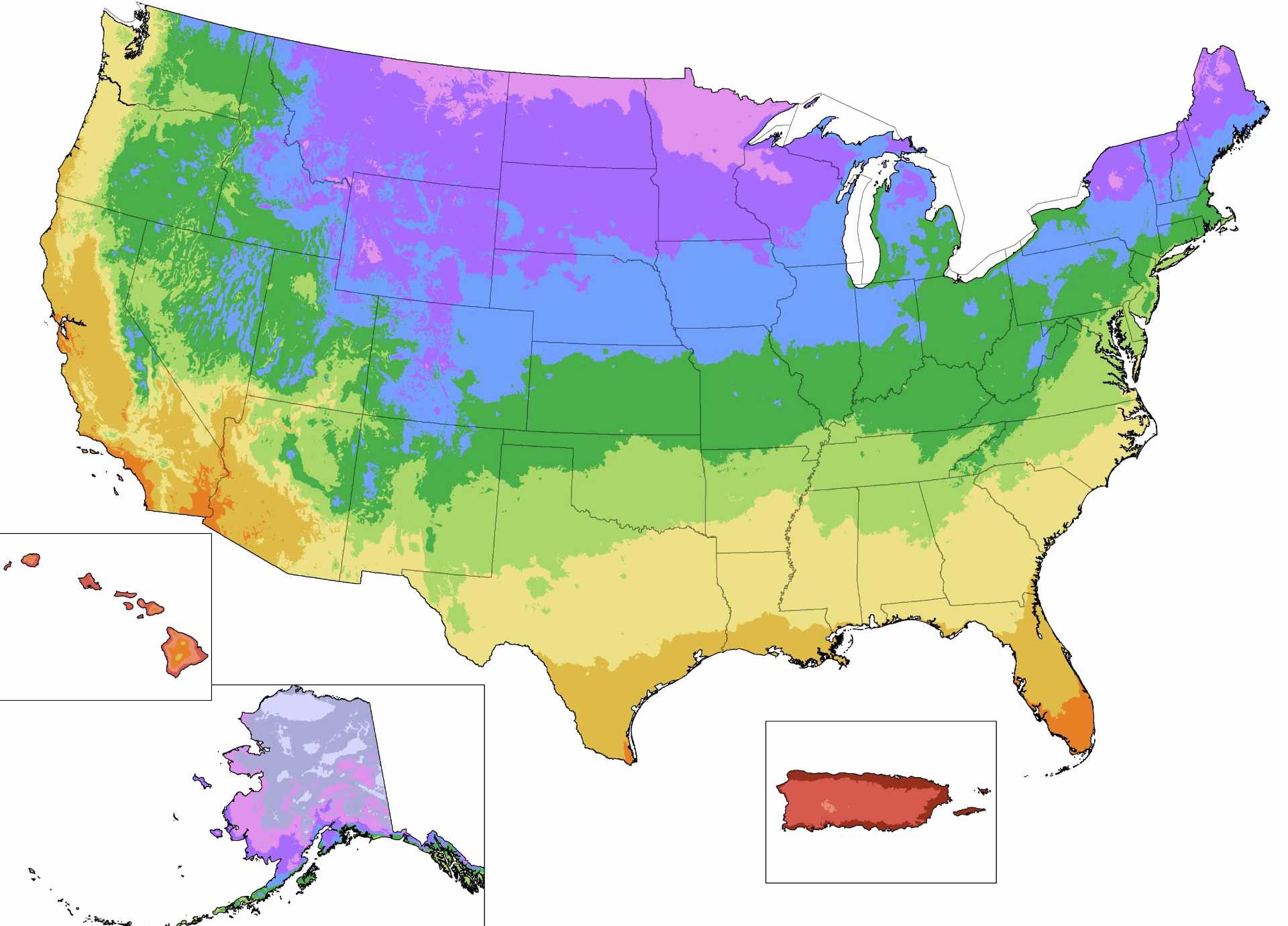What are Zones?

The term “zone” is often used in gardening and horticulture to refer to plant hardiness zones. These are geographic areas that are defined by the average minimum temperature that occurs in that area during winter.
The United States Department of Agriculture (USDA) has divided North America into 13 plant hardiness zones based on the minimum winter temperature ranges. Each zone is separated by a difference of 10 degrees Fahrenheit. For example, Zone 1 has an average minimum temperature of -60 to -50 degrees Fahrenheit, while Zone 13 has an average minimum temperature of 60 to 70 degrees Fahrenheit.
Plant hardiness zones are useful for gardeners and growers because they help determine which plants are likely to thrive in a particular area. Knowing the hardiness zone for a particular location can help gardeners select plants that are well-suited to the local climate and weather conditions.
How Many Zones?
Here is a brief description of the 13 plant hardiness zones as defined by the United States Department of Agriculture (USDA):
- Zone 1: This is the coldest zone, with an average minimum temperature of -60 to -50 degrees Fahrenheit. Only a few tough plants, such as the Arctic willow and Siberian fir, can survive in this zone.
- Zone 2: This zone has an average minimum temperature of -50 to -40 degrees Fahrenheit. Some plants that can grow in this zone include the Alaska cedar, juniper, and holly.
- Zone 3: This zone has an average minimum temperature of -40 to -30 degrees Fahrenheit. Plants that can thrive in this zone include the white spruce, red maple, and birch.
- Zone 4: This zone has an average minimum temperature of -30 to -20 degrees Fahrenheit. Some plants that can grow in this zone include the Colorado blue spruce, white oak, and crabapple.
- Zone 5: This zone has an average minimum temperature of -20 to -10 degrees Fahrenheit. Plants that can thrive in this zone include the eastern redbud, Japanese maple, and lilac.
- Zone 6: This zone has an average minimum temperature of -10 to 0 degrees Fahrenheit. Some plants that can grow in this zone include the dogwood, magnolia, and hydrangea.
- Zone 7: This zone has an average minimum temperature of 0 to 10 degrees Fahrenheit. Plants that can thrive in this zone include the crape myrtle, southern magnolia, and daylily.
- Zone 8: This zone has an average minimum temperature of 10 to 20 degrees Fahrenheit. Some plants that can grow in this zone include the sweet bay magnolia, fig, and oleander.
- Zone 9: This zone has an average minimum temperature of 20 to 30 degrees Fahrenheit. Plants that can thrive in this zone include the citrus trees, avocado, and bougainvillea.
- Zone 10: This zone has an average minimum temperature of 30 to 40 degrees Fahrenheit. Some plants that can grow in this zone include the banana tree, coconut palm, and passionflower.
- Zone 11: This zone has an average minimum temperature of 40 to 50 degrees Fahrenheit. Plants that can thrive in this zone include the pineapple, papaya, and plumeria.
- Zone 12: This zone has an average minimum temperature of 50 to 60 degrees Fahrenheit. Some plants that can grow in this zone include the olive tree, dragon fruit, and hibiscus.
- Zone 13: This is the warmest zone, with an average minimum temperature of above 60 degrees Fahrenheit. Plants that can thrive in this zone include the mango tree, coconut palm, and bamboo.
Who are included in Zones 1-5?
Zone 1:
- Alaska
- parts of Canada (Yukon, Northwest Territories, and Nunavut)
Zone 2:
- Alaska
- parts of Canada (British Columbia, Alberta, Saskatchewan, Manitoba, and Ontario)
- northernmost parts of the United States (Minnesota, North Dakota, Montana, and Maine)
Zone 3:
- Alaska
- parts of Canada (Ontario, Quebec, and New Brunswick)
- northern parts of the United States (Montana, North Dakota, South Dakota, Minnesota, Wisconsin, Michigan, New York, Vermont, New Hampshire, and Maine)
Zone 4:
- parts of Canada (Ontario, Quebec, New Brunswick, Nova Scotia, and Prince Edward Island)
- northern and central parts of the United States (Washington, Oregon, Idaho, Montana, North Dakota, South Dakota, Nebraska, Kansas, Colorado, Wyoming, Utah, Iowa, Minnesota, Wisconsin, Michigan, Illinois, Indiana, Ohio, Pennsylvania, New York, Vermont, New Hampshire, and Maine)
Zone 5:
- parts of Canada (Ontario, Quebec, New Brunswick, Nova Scotia, Prince Edward Island, and Newfoundland)
- central and northeastern parts of the United States (Washington, Oregon, Idaho, Montana, North Dakota, South Dakota, Nebraska, Kansas, Colorado, Wyoming, Utah, Iowa, Missouri, Illinois, Indiana, Ohio, Pennsylvania, West Virginia, Maryland, Delaware, New Jersey, New York, Connecticut, Rhode Island, Massachusetts, Vermont, New Hampshire, and Maine)
Who are included in Zones 6-10?
Zone 6:
- Midwest and mid-Atlantic regions of the United States (North Dakota, South Dakota, Nebraska, Kansas, Missouri, Oklahoma, Arkansas, Tennessee, Kentucky, Virginia, North Carolina, and South Carolina)
- parts of the Pacific Northwest (Oregon and Washington)
Zone 7:
- southern Midwest and mid-Atlantic regions of the United States (Kansas, Oklahoma, Arkansas, Tennessee, Kentucky, Virginia, North Carolina, and South Carolina)
- southern parts of the Northeast (Maryland, Delaware, New Jersey, and parts of Pennsylvania)
- parts of the Southeast (Georgia, Alabama, Mississippi, and Louisiana)
- parts of the Southwest (Texas, New Mexico, and Arizona)
Zone 8:
- parts of the southern and central United States (Texas, Oklahoma, Arkansas, Louisiana, Mississippi, Alabama, Georgia, Florida, South Carolina, and North Carolina)
- parts of the Southwest (New Mexico and Arizona)
- parts of the Pacific Northwest (Washington and Oregon)
Zone 9:
- southern and coastal regions of the United States (Florida, Louisiana, Texas, and parts of California)
- parts of the Southwest (Arizona, New Mexico, and Nevada)
Zone 10:
- southern regions of the United States (Florida, Texas, California, and Hawaii)
- parts of the Southwest (Arizona and Nevada)
Who are included in Zones 11-13
Zone 11:
- southernmost regions of the United States (Florida, Texas, and Hawaii)
- parts of California
Zone 12:
- Hawaii
- Puerto Rico
- the Virgin Islands
- other Pacific islands such as Guam and American Samoa
Zone 13:
- Puerto Rico
- the Virgin Islands
- other Caribbean islands such as the Bahamas, Jamaica, and the Dominican Republic


